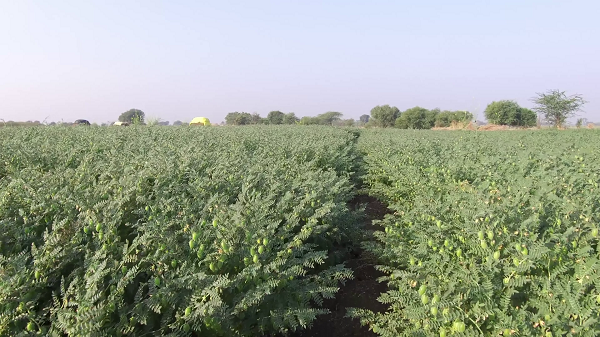
BY ALAZAR SHIFERAW
Today, the rapidly increasing population pressure, widespread environmental degradation, recurrent drought, low productivity of the agricultural sector and limited market access have greatly contributed to critical food shortages not only in Ethiopia but also in some parts of the world, Ethiopian Journal of Agriculture stated.
These challenges in turn have resulted in food insecurity, which is characterized by inability of the people to have physical and economic access to sufficient food to meet their dietary needs for a productive and lead healthy life. Therefore; there is a great in need of intensifying agricultural researches on various agricultural crops. But although presently there are several crop variety findings which can increase productivity, yet further research studies should be carried out to improve varieties that can increase crop production, to ensure food security in the country, it added.
In this regard, among other things, a research on chickpea; an excellent source of food is indicating a promising result. Professionals in the field say that chickpea is an important pulse crop grown and consumed all over the world, especially in the Afro-Asian countries. It is a good source of carbohydrates and protein, and protein quality is considered to be better than other pulses.
Chickpea has significant amounts of all the essential amino acids except sulphur containing amino acids, which can be complemented by adding cereals to the daily diet. Starch is the major storage carbohydrate followed by dietary fiber, oligosaccharides and simple sugars such as glucose and sucrose, they said.
What is more, according to Journal of Dryland Agriculture, chickpeas are a nutrient dense food. It has a 20 percent protein content and is also high in dietary fiber, folate, and dietary mineral content. They are also rich in essential amino acids. Apart from being excellent sources of food, chickpeas play a significant role in improving soil fertility by fixing the atmospheric nitrogen made it available for crop uptake.
Although lipids are present in low amounts, chickpea is rich in nutritionally important unsaturated fatty acids such as linoleic and oleic acids. β-Sitosterol, campesterol and stigmasterol are important sterols present in chickpea oil. Ca, Mg, P and, especially, K are also present in chickpea seeds. Chickpea is a good source of important vitamins such as riboflavin, niacin, thiamin, folate and the vitamin A precursor β-carotene, it added.
As with other pulses, chickpea seeds also contain anti-nutritional factors which can be reduced or eliminated by different cooking techniques. Chickpea has several potential health benefits and, in combination with other pulses and cereals, it could have beneficial effects on some of the important human diseases such as type 2 diabetes, digestive diseases and some cancers. Overall, chickpea is an important pulse crop with a diverse array of potential nutritional and health benefits, it said.
Although chickpea is regarded as a drought tolerant crop, it is important to identify drought tolerance mechanism so as to develop new cultivars with high yield potential. Breeding chickpea resistant to drought should focus on the introduction or exploration of chickpea germplasm through interchange of genetic material, probing areas with greater genetic variation, collaboration with international research institutes.
An article published on Ethiopian Journal of Agriculture under the title Rapid Generation Advance in Chickpea for Accelerated Breeding Gain in Ethiopia: What Speed Breeding Imply by Dr. Asnake Fikre and Tulu Degefu among others said that there are key roles of the crop improvement over decades to enhance the productivity, revenue generation power farming culture of Chickpea in Ethiopia, which is the secondary center of its diversity.
Modern breeding approaches are increasingly being deployed in legumes such as chickpea to enable the rapid development of improved varieties with enhanced yields under challenging climatic conditions .Understanding the genetics of simple or complex traits has involved the use of multiple approaches association genetics, it said.
The draft genome sequence and sequence information on germplasm lines has provided opportunities to harness chickpea’s whole diversity for trait improvement. Since understanding these traits by developing multi-parent populations is resource intensive and time consuming, the rapid development of populations will enable trait dissection and development of new varieties, it said.
Nonetheless, climate change events along with dynamics of product demands necessitate rapid breeding cycles and swifter replacement of old varieties to ensure speedier genetic gains and sustainable food and nutritional security.
It is predicted that feeding a global population exceeding nine billion by 2050 will require 2 percent genetic gain. The length of a breeding cycle or generation interval is inversely proportional to the rate of genetic gain. Although over 350 improved varieties of chickpea have been released across the globe, unlike in the major cereals, the development of new varieties and variety replacement rates have been slow in legumes. Most breeding programs evaluate fixed lines which must be generated via crossing parental lines and subsequent inbreeding for 5-6 generations, it said.
However, crop duration and photoperiod sensitivity hinders the achievement of multiple generations per year. Although chickpea’s maturity ranges from 80 to 180 days depending on genotype, soil moisture, temperature, latitude and altitude; most breeding programs routinely achieve two generations per year -one in the field during the crop season and the other in the off-season either in a greenhouse or in an off-season irrigated nursery. While many use double haploid technology to accelerate development of homozygous (inbreed) lines efficient methods are not yet readily available in chickpea.
Rapid generation cycling or advance has been used in several crops to accelerate breeding including in vitroculturing, embryo rescue or simplified biotron or photons based extended growth techniques. The recent rapid generation advance technology also known as ‘speed breeding’ uses extended photoperiod and controlled temperature to grow up to 6 generations of chickpea per year.
However, to control the environmental conditions it requires investment in infrastructure, which can be challenging to establish and or adapt in every breeding programof the less resource system.
As a low-cost and easily adaptable alternative, this study reports a field-based technique for rapid generation advance that can be used to cycle at least four generations of chickpea per year. The methodology providing in chickpea is easy to adopt, simple but effective, and can facilitate fast-track development of populations for pre-breeding and breeding to ultimately enhance the development of improved varieties, it said.
The Ethiopian Herald April 16/2021



